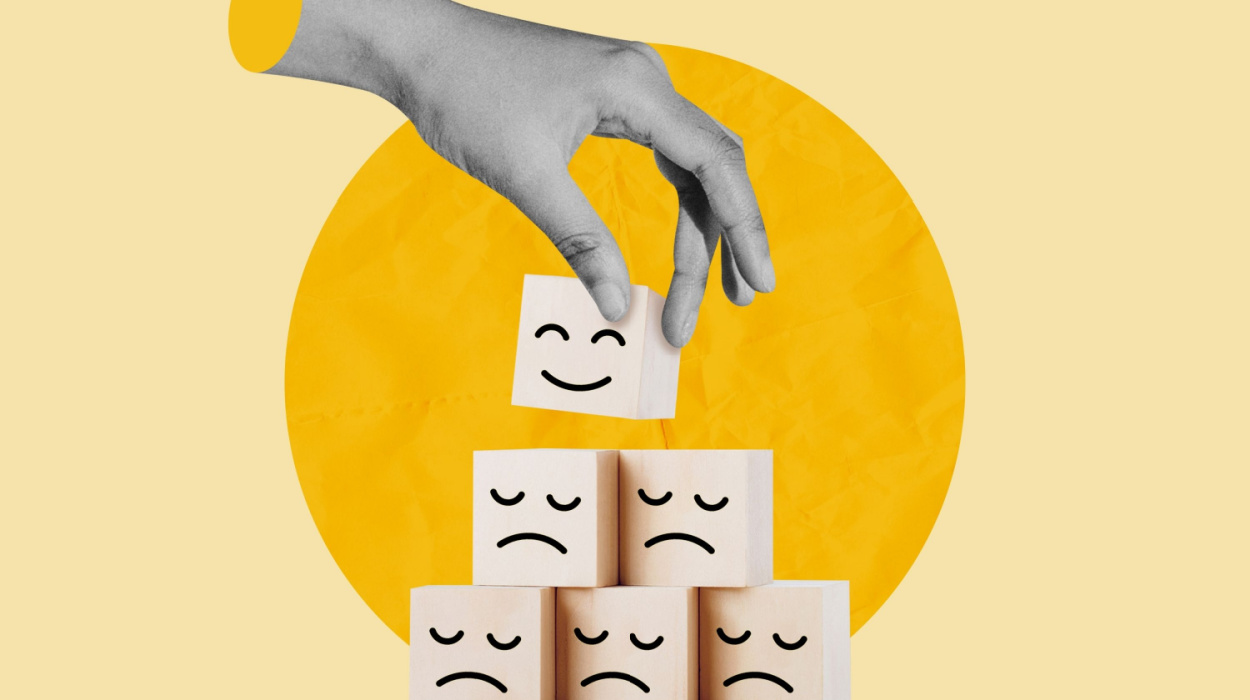The National Institute of Mental Health provides statistics related to the prevalence of mental health disorders. These data offer information about common mental health conditions, including who they affect. The latest data show that mental health needs are common among Americans.
After the coronavirus pandemic, most of us probably became accustomed to hearing about rates of mental illness. The latest data show mental health statistics 2023[1] that have emerged post-pandemic. It’s helpful to take a look at these numbers so we can determine who is struggling with psychological distress.
Below, find information related to a number of mental health conditions, including mood disorders, obsessive-compulsive disorder, and substance use disorders. If you or someone you know is struggling, you’re not alone.
Hopefully, looking at these numbers will encourage you to seek mental health support if you need it.
Key Mental Health Facts 2023
- Surveys show that 21%[2] of adults in the U.S. are experiencing at least one mental illness. That’s roughly 50 million people.
- Furthermore, 55%[2] of the nation’s adults with a mental illness have not received any treatment.
- And a significant number, 5.44%[2] of U.S. adults, experience severe mental illness.
- A survey by the National Center for Health Statistics shows that symptoms of anxiety in America have risen to 40%[2] in 2020 from 11% in 2019.[3]
- Slightly over one-fourth[4] of U.S. women have a mental health diagnosis. Mental illness is more common in women compared to men.
Mental Health Statistics
In Adults
Mental Health Illness Rate By Sex
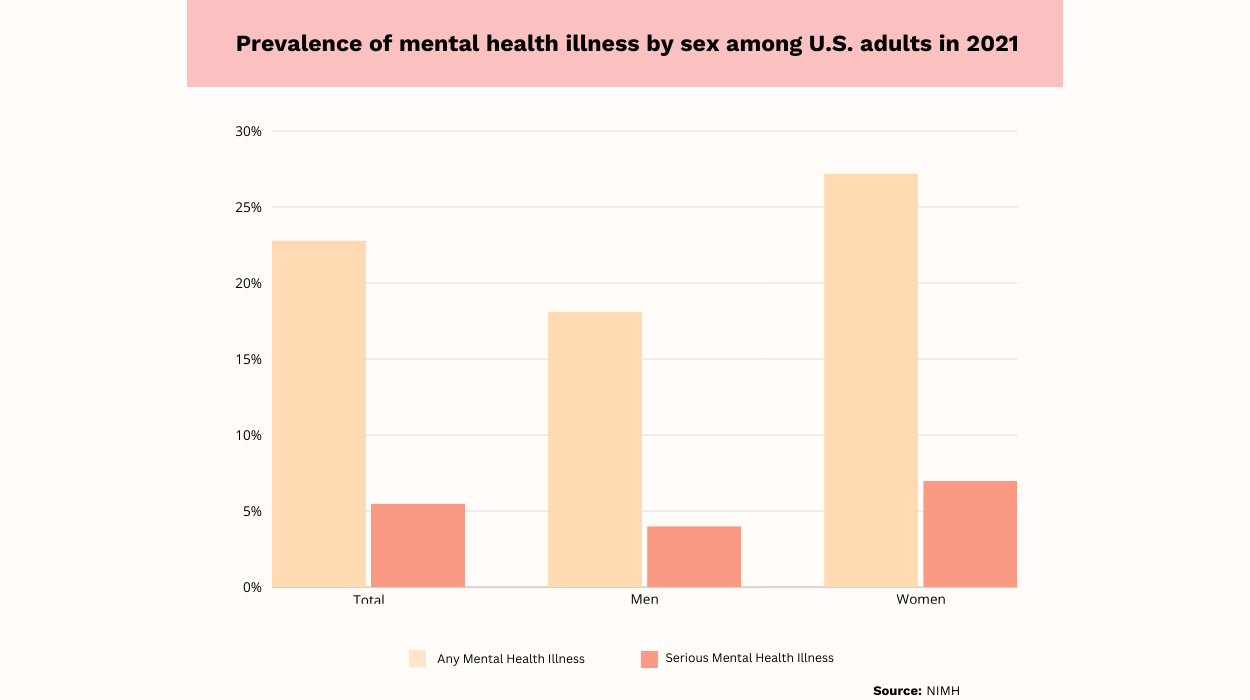
- In 2021, about 57.8 million[4] adults aged 18 and above had any mental illness, abbreviated as AMI. This means 22.8%[4] of all U.S. adults had a mental health diagnosis.
- In 2021, about 14.1 million[4] U.S. adults had a serious mental illness, abbreviated as SMI. This means that 5.5%[4] of the adult population experienced an SMI.
- Women were more likely than men to have AMI, with a prevalence of 27.2%[4] and 18.1%, respectively.
- Women were also more likely than men to have SMI, with a prevalence of 7.0%[4] and 4.0%,[4] respectively.
It’s helpful to understand that the category of AMI includes a range[4] of different mental health disorders. This includes those that cause only mild to moderate impairment, as well as those that cause severe impairment. Thus, the AMI category also includes those with SMI.
The bottom line is that just over one-fifth[4] of American adults have any mental health diagnosis. Just over one-fourth[4] of women have a diagnosis, showing that women are more likely to be affected than men.
Mental Health Illness By Age
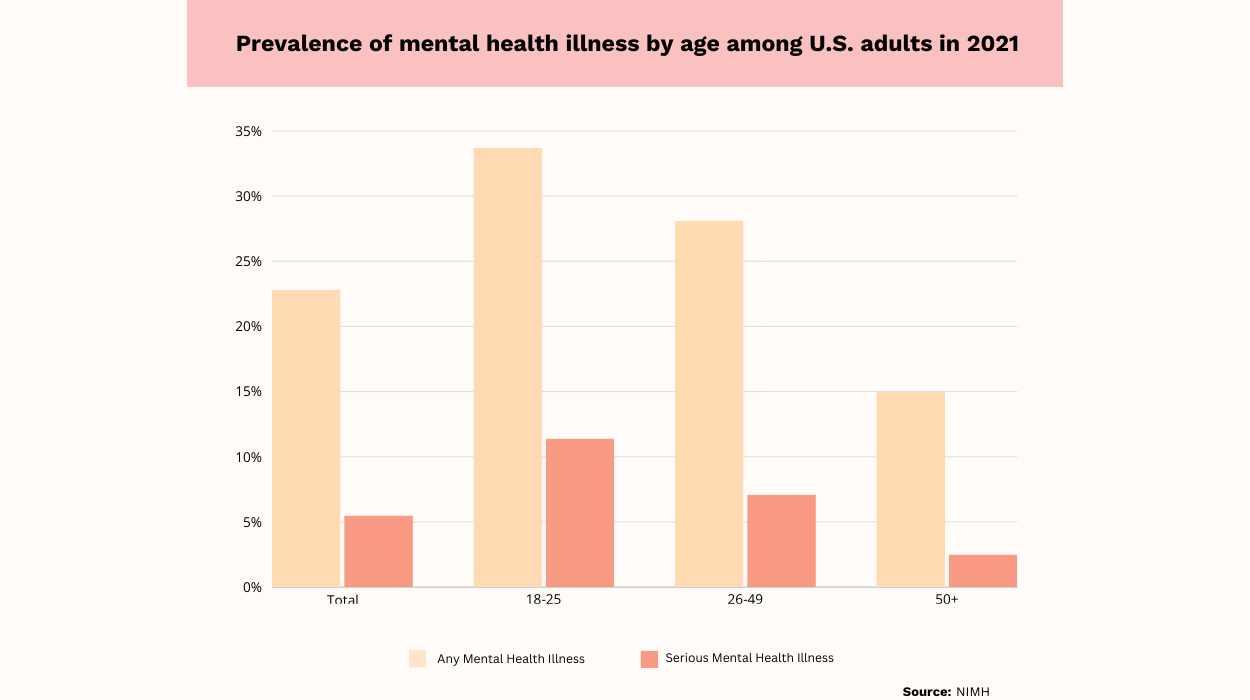
- The prevalence of AMI is highest in young adults aged 18-25. In this population, 33.7%[4] of people have a mental health disorder.
- In adults aged 26-49, 28.1%[4] have a mental illness.
- The lowest rates of AMI are in those aged 50 and above, for whom 15.0%[4] have a mental health diagnosis.
- For SMI, the prevalence is 11.4%[4] for young adults aged 18-25. This is compared to 7.1%[4] for those 26-49 and 2.5%[4] for those 50 and above.
Young adults in the range of 18 to 25 years of age are the hardest hit by AMI and SMI. The prevalence of both AMI and SMI declines across older age cohorts. Adults aged 50 and above have the lowest rates of both AMI and SMI.
Mental Health Illness By Race Or Ethnicity
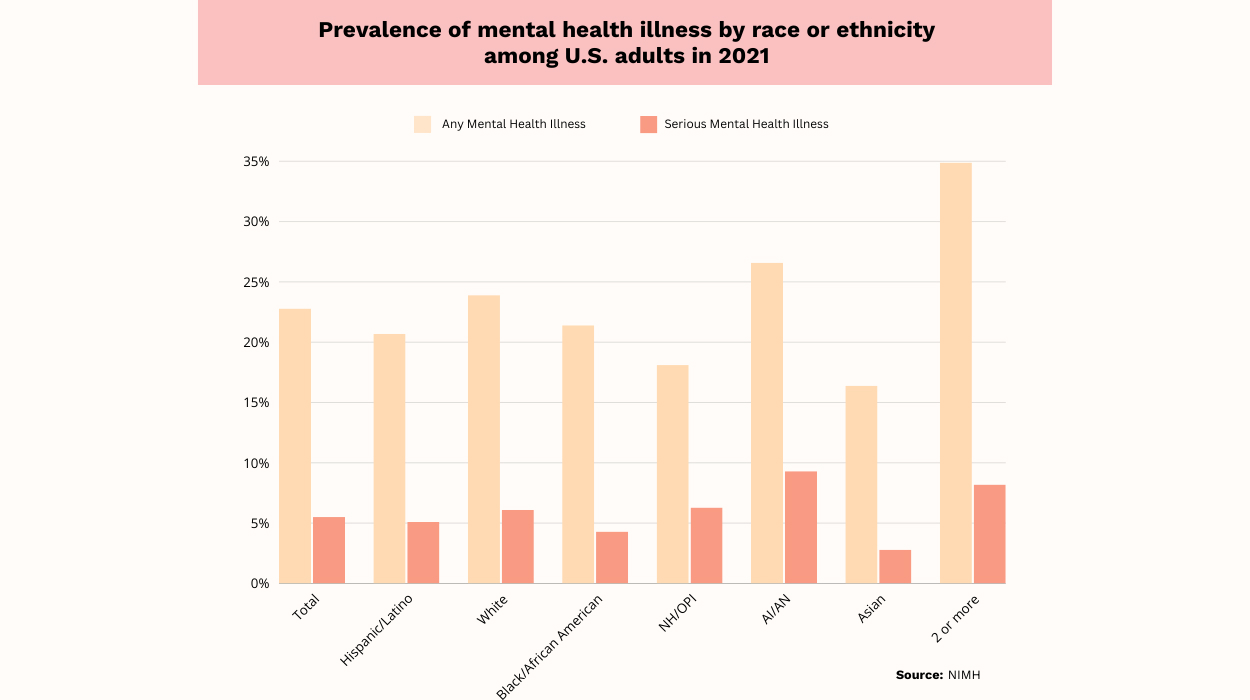
- The rate of AMI is highest among individuals of two or more races, for whom the prevalence is 34.9%.[4]
- American Indian/Alaskan Natives have the second highest prevalence of AMI, at 26.6%.[4]
- Among all adults, Asians have the lowest prevalence of AMI, at 16.4%.[4]
- Serious mental illness is more common in American Indian/Alaskan Natives, with a prevalence of 9.3%[4] in this group.
- Adults reporting two or more races have the second-highest SMI rate at 8.2%.[4]
- The lowest rate of SMI, at 2.8%,[4] is among Asians.
Asians consistently have the lowest rates of mental illness, whether it is a serious mental illness or any mental illness. On the other hand, individuals of two or more races and American Indian/Alaskan Native populations have the highest rates.
In Youth
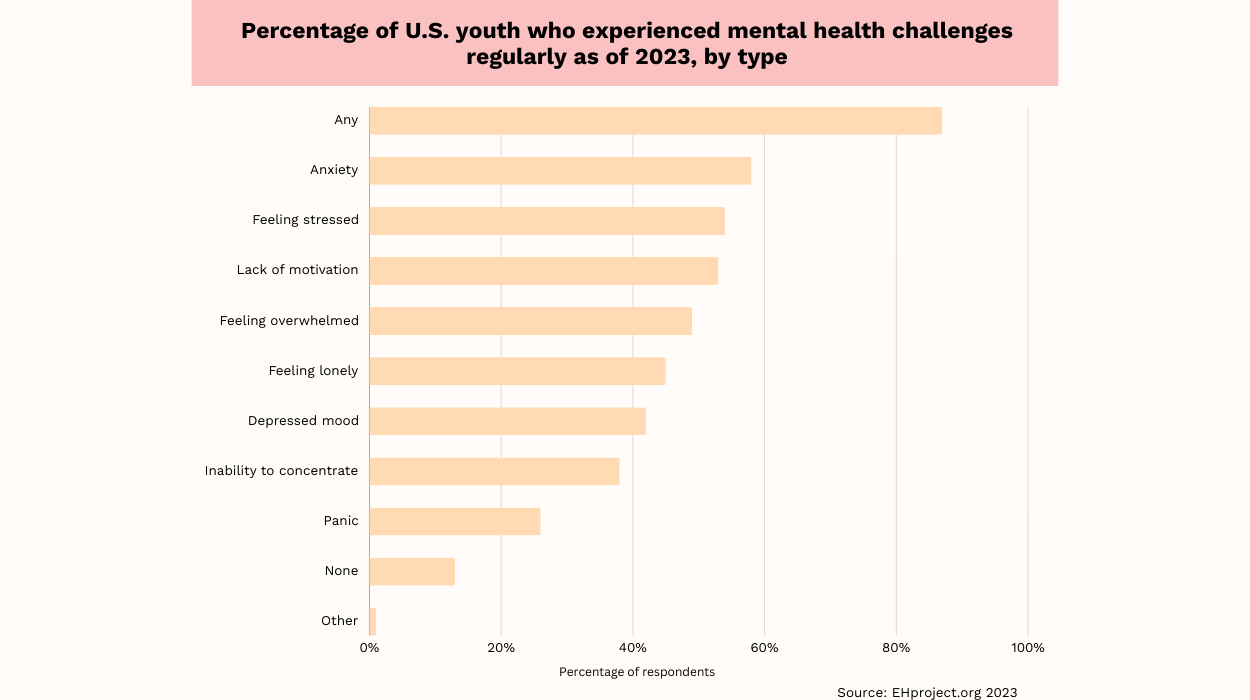
- U.S. youth regularly experience mental health challenges. As of 2023, 87%[5] experienced at least one type of mental health challenge.
- Among the different types of mental health challenges in youth, anxiety is the most common. In 2023, 58%[5] of youth regularly experience anxiety.
- Stress falls closely behind anxiety as the second most prevalent mental health challenge in U.S. youth. Over half of youth, 54%,[5] regularly feel stressed.
- Among youth, 42%[5] regularly struggle with a depressed mood.
- Over a quarter of youth, 26%,[5] regularly feel panicked.
Based on the data, America’s youth require mental health support. Many of them are struggling with feelings that could be indicative of a mental health disorder.
In Children
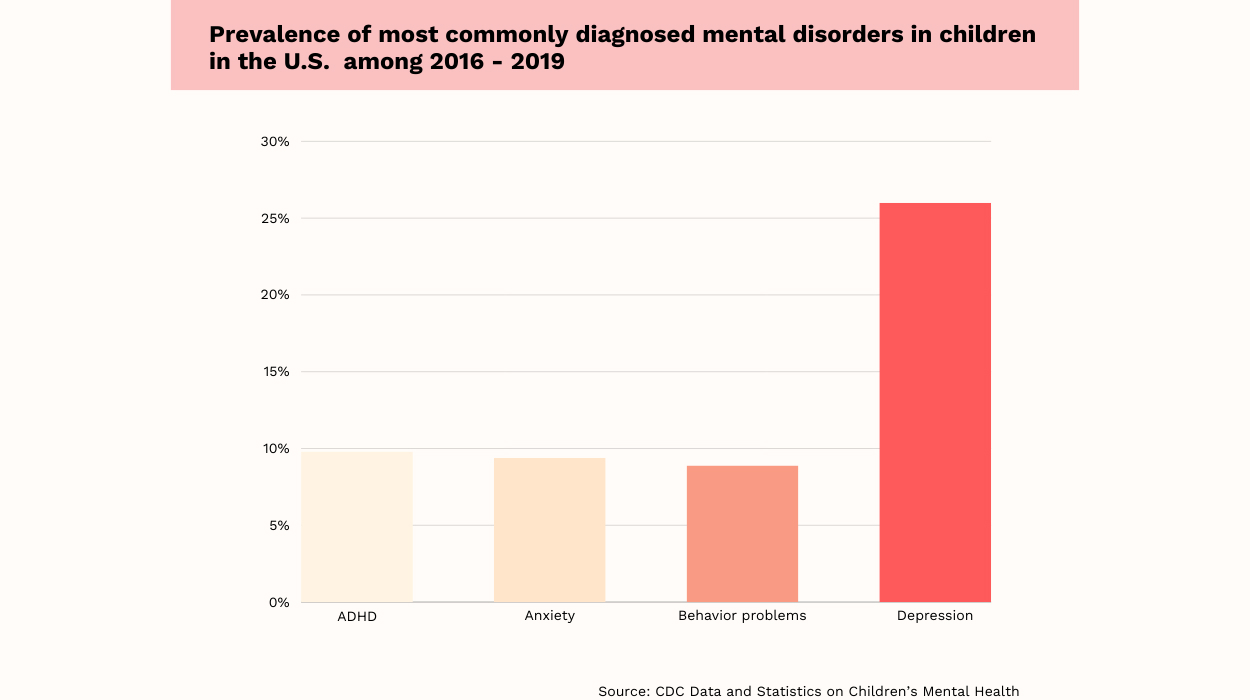
- Among children aged 3-17, ADHD is the most common diagnosis, affecting 9.8%[6] of those in this age group. Anxiety falls close behind, with a prevalence of 9.4%.[6]
- Of children 3-17, 8.9%[6] experience behavior problems, and 4.4%[6] experience depression.
- This means that about 6.0 million[6] children are living with ADHD; about 5.8 million[6] experience anxiety and around 5.5 million[6] have behavior problems.
- An additional 2.7 million[6] children have depression.
ADHD is common in children, with nearly one out of 10[6] having an ADHD diagnosis. Anxiety is also common in youth, affecting almost as many children as ADHD. While depression is not as common as ADHD and anxiety, it still affects almost one out of every 20 children.
Even depressive disorders can start early in life, and they are especially common in teens. National data showed that in adolescents aged 12 to 17, depression prevalence increased from 8.1% to 15.8%[7] between 2009 and 2019.
Mental Health Care Matters
Any Mental Health Illness (AMI)
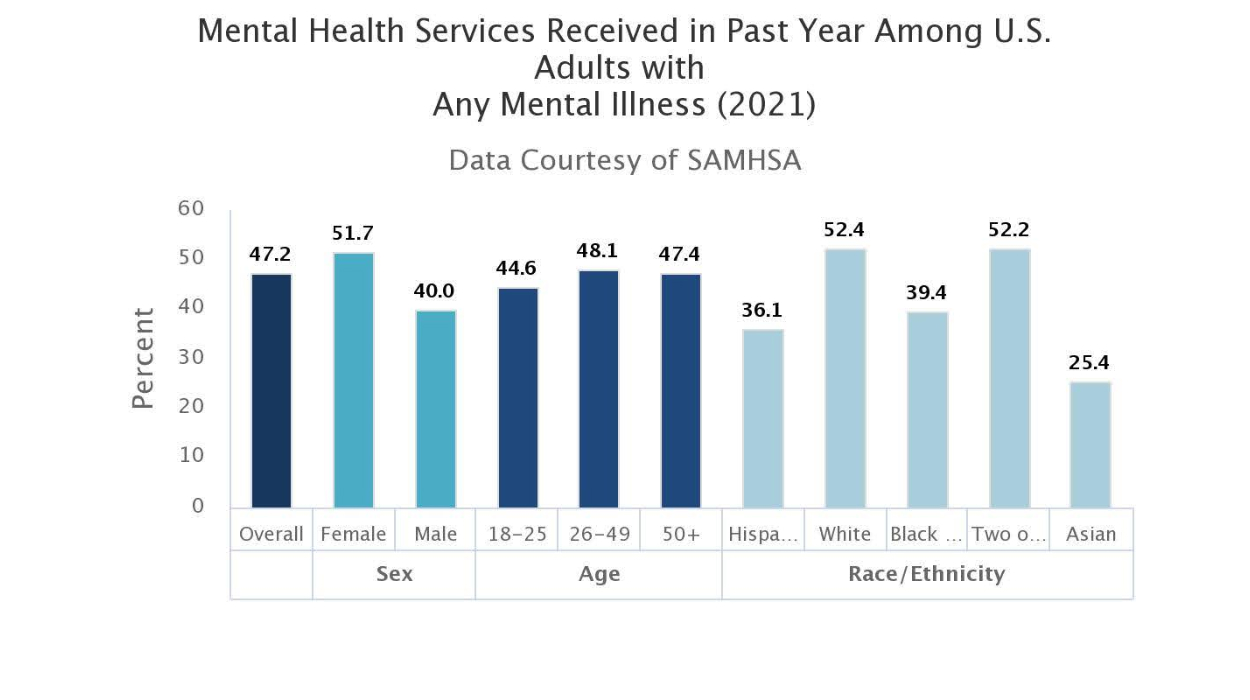
- Not everyone who needs mental health treatment receives it. Just 47.2%[4] of people with AMI received services within the past year as of 2021.
- Women are more likely than men to receive mental health treatment, with 51.7%[4] of women engaging in treatment. This is compared to 40.0%[4] of men.
- There isn’t much variation in treatment rates based on age. In young adults aged 18-25, 44.6%[4] receive treatment, compared to 48.1%[4] aged 26-49 and 47.4%[4] aged 50 and up.
- Receipt of treatment varies by race. Just over half of Whites, or 52.4%, receive treatment for a mental illness. This rate is comparable to that for people of two or more races, which is 52.2%. Asians have the lowest rates of treatment-seeking, 25.4%.[4]
Whether U.S. adults participate in mental health treatment varies more based on sex and race/ethnicity than based on age. Women are more likely than men to receive treatment for AMI.
Whites and those of two or more races are the most likely to receive treatment. The rates are lowest for Asians, with Hispanics having the second lowest rates of receiving treatment.
Serious Mental Health Illness (SMI)
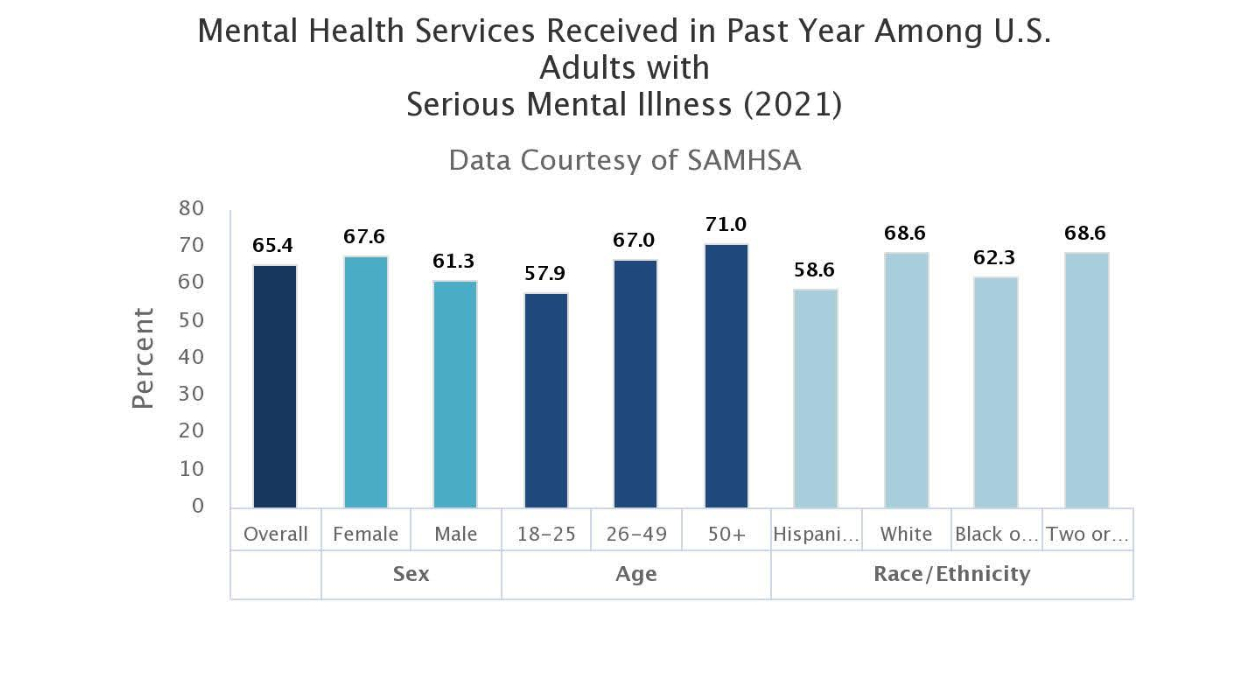
- Among those with SMI, 65.4%[4] received treatment in the past year, as of 2021.
- Women were slightly more likely than men to receive treatment for SMI, with rates of 67.6%[4] and 61.3%,[4] respectively.
- Young adults with SMI were the least likely to receive treatment. Only 57.9%[4] of those aged 18-25 received treatment, compared to 67.0%[4] of those aged 26-49 and 71.0%[4] of those aged 50 and up.
- Hispanics are the least likely to receive SMI treatment, with 58.6%[4] of this group engaging in treatment. This is compared to 68.6%[4] of Whites, 62.3%[4] of Blacks, and 68.6%[4] of those of two or more races.
Based on the data above, individuals with severe mental health conditions are more likely to receive treatment compared to those with AMI. Consider the fact that just 47.2%[4] of people with AMI receive treatment, compared to 65.4%[4] of those with SMI.
Other Facts About Mental Health
There are some additional facts about mental health conditions that are worth examining. The Substance Abuse and Mental Health Services Administration publishes yearly reports about the prevalence of mental illness and substance use disorders. These reports provide insights into mental health trends over time.
Consider the following figures from recent reports:
- In 2016, 18.3%[8] of U.S. adults had a mental health disorder within the last year. By 2021, 22.8%[9] had a mental health condition in the last year, demonstrating an increase.
- In 2016, 4.2%[8] of adults had SMI, compared to 5.5%[9] in 2021.
- As of 2021, 7.6%[9] of adults had both mental disorders and substance use disorders. This represents 19.4 million[9] people.
- In 2016, 8.2 million[8] adults had both a mental health condition and a substance use disorder.
- Currently, 2023 depression statistics are not yet available, but the latest data from 2021 show that 8.3%[9] of adults had depression within the past year.
- In 2016, 6.7%[8] of adults had an episode of depression within the past year.
In summary, these trends show that rates of mental health conditions and substance use disorders have increased since 2016. More people are experiencing episodes of depression as well.
Below are some additional facts about mental health in 2023:
- U.S. adults with mental health conditions are more likely to be unemployed. Their unemployment rate is 7.4%,[10] compared to 4.6%[10] of those without a mental illness.
- Among U.S. adults 18 and over, 5.7%[9] of people experience depression with severe impairment. Of those aged 18 to 25, 13.3%[9] experience depression with severe impairment.
What Is Mental Health?
The term “mental health” describes[11] a person’s overall well-being, psychologically, emotionally, and socially. A person’s mental health status influences how they think, interact with other people, and respond to stress.
Mental health is important throughout the entire lifespan. If a person is struggling with mental health, it doesn’t necessarily mean they have a mental illness. On the other hand, a person can be diagnosed with a mental illness and still experience good mental health.
Sometimes, the terms “mental health” and “mental illness” are used interchangeably. It’s important to understand that there are differences between the two. A mental illness is a diagnosable condition that interferes with a person’s daily functioning.
When a person has a mental illness, they experience differences in thinking, feeling, and perceiving the world. These differences can cause distress or make it difficult for a person to function in important areas, like work or school.
Common Types Of Mental Health Issues And Illnesses
The National Institute of Mental Health[12] publishes data and information related to common mental health disorders. However, some of this data is not recent since it is based on the National Comorbidity Study Replication from 2001-2003. Nonetheless, this government source provides credible information about the most common types of mental illness in the U.S.
Based on available data,[13] these are the most common mental health disorders in the United States:
Most Commonly Diagnosed Mental Health Issues
- Anxiety disorders: There are various types of anxiety disorders, including phobias, generalized anxiety disorder, and social anxiety disorder. Individuals with an anxiety disorder experience excessive fear and worry, which changes their behavior. According to the most recent data, 19.1%[14] of U.S. adults have an anxiety disorder over a year.
- Major depression: As of 2021, 8.3%[15] of U.S. adults had a depressive episode within the last year. People living with depression experience a depressed mood alongside other symptoms. These can include a lack of interest in usual activities, fatigue, and difficulty concentrating.
- ADHD: Attention-deficit/hyperactivity disorder, often called ADHD, is most commonly diagnosed in children. Children with ADHD have a difficult time remaining focused, exerting self-control, and managing hyperactivity. The latest data show that 11.0%[16] of children have ADHD, increasing by 3% since 2003.
- Personality disorders: There are various types of personality disorders. These conditions exist when a person’s pattern of thinking, feeling, and behaving differs from what is expected in their culture. The most recent national data show a prevalence of 9.1%[17] for personality disorders in U.S. adults.
The mental health disorders above are the most commonly diagnosed in the United States. However, there are additional mental health diagnoses. The following disorders, albeit less common, do occur in Americans:
Other Mental Health Illnesses
- Bipolar disorder: Individuals with bipolar disorder experience shifts in mood state. Their moods shift from periods of depression to periods of an elevated mood called mania or hypomania. Within a given year, about 2.8%[18] of U.S. adults have bipolar disorder.
- Schizophrenia: This is a serious mental health condition that causes disturbances in a person’s thinking, perception, emotions, and social skills. A person with schizophrenia can experience psychotic symptoms, such as hallucinations. Just 0.25-0.64%[19] of people in the U.S. have schizophrenia and have a shortened life expectancy[20] of 10-20 years earlier than their healthy counterparts.
- Obsessive-compulsive disorder: Obsessive-compulsive disorder involves unwanted, upsetting thoughts called obsessions. A person with obsessive-compulsive disorder engages in repetitive behaviors called compulsions to try to alleviate stress from obsessive thoughts. Within a given year, about 1.2%[21] of U.S. adults have obsessive-compulsive disorder.
- Eating disorders: There are several different eating disorders. What they have in common is disturbances in eating habits as well as a fixation on weight and body shape. The prevalence of eating disorders in U.S. adults ranges from 0.3%[22] for bulimia to 1.2%[22] for binge eating disorder.
- Post-traumatic stress disorder: Post-traumatic stress disorder develops after exposure to an event like assault or sexual violence. It involves symptoms like flashbacks, sleep disturbances, and unwanted memories of the traumatic event. Within a given year, about 3.6%[23] of U.S. adults experience PTSD.
Suicide Rates
Suicide in and of itself is not a mental health disorder. However, having a diagnosis like depression can increase[24] the risk of suicide. When looking at statistics on mental illness, it’s essential to consider suicide rates.
Consider the following data:
- Provisional data show that suicide deaths in the U.S. increased 2.6%[25] between 2021 and 2022.
- There were an estimated 49,449[25] suicide deaths in 2022.
- From 2021 to 2022, there was a reduction in suicide deaths in youth people aged 10-24. Numbers declined 8.4%[25] for this age range.
- American Indian and Alaskan Native populations also saw a decline in suicide deaths. For this group, the death rate declined by 6.1%[25] between 2021 and 2022.
- In Native Hawaiian or Other Pacific Islander populations, suicides increased by 15.9%[25] between 2021 and 2022.
- In 2022, there were 10,194[25] suicide deaths in women and 39,255[25] in men.
- From 2021 to 2022, the number of suicide deaths increased by 8.1%[25] among those aged 65 and above.
Suicide deaths increased slightly between 2021 and 2022, nearing 50,000 deaths from suicide by 2022. More men die by suicide when compared to women.
Despite the overall increase in suicide deaths, young people, American Indians, and Alaskan Natives saw declines in suicide numbers. On the other hand, suicide rates increased notably in Native Americans and Other Pacific Islanders. They also increased among older adults.
Tips To Manage Your Mental Health Issues In Daily Life
If you have a mental health diagnosis, there are steps you can take to manage it. Consider the tips below:
- Practice self-care: This means taking time for relaxation, getting regular physical activity, and eating nutritious foods.
- Establish a support network: Talk to trusted family and friends about your feelings. You could also attend a local support group for individuals with a mental health diagnosis.
- Get involved in the community: Mental health awareness events can connect you to others passionate about this topic. View the 2023 Mental Health Awareness Calendar online for ideas on community events.
- Seek treatment: Mental health disorders can be managed with treatment. In most cases, talk therapy and/or medication are used[26] to treat mental illness. Contact your primary doctor if you need a referral to services.
Conclusion
Mental illness is common in the United States, with just over one out of five adults[4] having any mental health diagnosis. The prevalence can vary based on sex, age, and race/ethnicity. However, the fact remains that mental health conditions are common.
Even the nation’s youth are experiencing mental distress. The most recent data show that in 2023, 87%[5] of youth regularly experience a mental health challenge.
The economic burden to society is enormous, yet only about 2% of the budget[20] is dedicated to mental health concerns. Individuals with mental health disorders must receive adequate treatment. This reduces the risk of consequences[27] like suicide, crime, and lost productivity.
If you or a loved one has a mental health condition, there is support available. Reach out to your doctor or a local mental health clinic to access services.
Frequently Asked Questions
Overall, 47.2%[4] of people with a mental health condition receive treatment. This means that 52.8%[4] go without treatment. Increasing treatment access is essential because poor mental health is linked[27] to poor educational outcomes and reduced income potential.
Mental illness is becoming more common, calling attention to the issue of mental well-being. In 2016, 18.3%[8] of U.S. adults had a mental health disorder within the past year. By 2021, this increased to 22.8%[9] of adults.
Global data[28] show that anxiety disorders are the most prevalent mental disorders. However, the global economic burden of disability is highest[28] for depressive disorders.
 Evidence Based
Evidence Based
